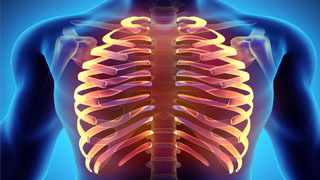
If you find that the ribs protrude outward or open upwards, this may cause aesthetic issues and may cause discomfort. Rib opening may be a result of muscle imbalance, and solving this problem is crucial for maintaining a healthy and balanced body.
In this article, we will discuss what rib opening is, the factors that cause it, and provide a step-by-step plan to help correct this issue. By implementing these techniques and exercises, you will improve your appearance and reduce the risk of related pain and injury.
One Reasons for rib valgus
A. Muscle imbalance
Rib opening may be caused by muscle imbalance, usually due to tension in the lower back. When the muscles in the lower back become tense, they shorten, causing excessive arching of the lower back.
This arch shape causes the anterior part of the pelvis to tilt downwards, and the ribs appear to be spreading out, almost like you're standing out. Meanwhile, weak core muscles are unable to counteract the tension in the waist, thus maintaining the outward appearance of rib abduction.
B. Congenital issues
Some people may experience rib valgus due to congenital issues or rib deformities such as pectus excavatum. In these cases, rib opening is caused by the structure of the chest cavity itself.
If you suspect that rib valgus is caused by congenital issues or past injuries, you must consult a specialist for further evaluation and guidance.
2、 Steps to solve rib abduction
We will focus on correcting the muscle imbalance identified in the previous section to address the issue of rib opening. The following are key areas that require special attention:
Massage tense muscles: Massaging tense muscles will help relieve tension and chronic tension in the back muscles.
Stretching Tight Muscles: Once the tight muscles are massaged, they are ready to be stretched to produce length.
Strengthening weak muscles: We will emphasize enhancing core strength to counteract tension in the waist and promote proper posture.
Flexibility exercises: Combining flexibility exercises with a focus on the top of the head will enhance overall flexibility and help prevent rib abduction.
3、 Massage techniques for muscle tension
We will use targeted massage techniques on the lower back muscles to release tension and improve flexibility. For this part, you need a foam shaft or massage ball.
Roll the lower back with the foam shaft
When lying on the floor, place the foam shaft under your lower back.
Support your weight with your hands and feet, gently roll back and forth on the roller, and apply pressure to the muscles in your lower back.
It is important to keep your lower back firm and not allow it to arch over the foam shaft when doing so.
Roll for about 1-2 minutes, focusing on massaging tight or sensitive areas.
Use a massage ball for waist massage
Lying on the floor with knees bent.
Place the massage ball under the lower back, on one side of the spine, targeting the tense muscles.
Gently roll the ball and apply pressure to any taut area.
Spend 1-2 minutes on each side of the lower back.
Foam axis rolls latissimus dorsi
Lie on your side with the foam shaft under your armpit and perpendicular to your body.
Extend your lower arm above your head.
Place your upper hand on the ground in front of you to maintain balance.
Slowly roll back and forth. When moving the foam shaft from the armpit to the waist, apply pressure to the latissimus dorsi.
Spend about 1-2 minutes on each side, focusing on tight or sensitive areas.
4、 Stretching overly active muscles
This section will introduce stretching exercises designed specifically for tight lower back and latissimus dorsi muscles.
Baby style posture
Start with your hands and knees, then sit back on your heels.
Extend your arms forward, shoulder width apart, and rest your forehead on the ground.
Maintain this position for 30 seconds to 1 minute and feel a slight stretch of the lower back and latissimus dorsi muscles.
Stretching of latissimus dorsi muscle
Place a chair or bench in front of you and kneel down.
Place your elbow on the water surface, shoulder width apart, and bend your arm at a 90 degree angle.
Press your chest to the ground and place your head between your arms.
Push your hips backwards, keeping your spine straight and core engaged.
Maintain for 20-30 seconds and feel the stretching of the latissimus dorsi and both sides of the chest.
Repeat 2-3 times.
5、 Strengthen the exercise of weak muscles
Enhancing core strength is crucial for maintaining correct posture and preventing rib opening. We will provide you with a series of exercises targeting your core muscles to help relieve tension in your waist.
Flat support
Starting from the push up position, the elbow is located directly below the shoulder.
Tighten the core muscles, squeeze the gluteus maximus, and maintain a straight line from the head to the heel.
Maintain this position for 30 seconds or longer, depending on your ability.
Dead bugs
Lie on your back, extend your arms above your chest, and bend your knees at a 90 degree angle.
Activate your core and slowly lower your right and left arms to the floor, pressing your lower back into the ground.
Return to the starting position and repeat this action with the other arm and leg.
Repeat 8-10 times on each side.
Side panel
Lie on your side, with your elbows directly below your shoulders and your feet folded together.
Activate your core and lift your hips off the ground, maintaining a straight line from head to toe.
Maintain this position for 30 seconds or longer, depending on your ability.
Repeat on the other side.
6、 Flexibility Exercise
People who experience rib valgus typically exhibit limited shoulder movement, especially when extending their arms over their heads. To compensate for this limited range of motion, they often spread their ribs and arch their backs while reaching their heads.
This section will focus on exercises that help you maintain the correct posture and core participation when raising your arms. This will improve your ability to perform daily activities without opening your ribs.
Raise the forearm
Stand with your feet spread apart, hip width apart, and your arms on either side of your body.
Slowly raise your arms in front of you, keeping them straight until they are above your head.
When you do this, keep the core tight and avoid letting the ribs open.
Return the arm to its starting position.
Repeat 8-10 times.
Wall Angel
Stand with your back against the wall, feet apart and hip width apart.
Bend your elbow at a 90 degree angle and press your forearm against the wall.
Slowly slide your arm onto the wall, stretch your arm as straight as possible, but do not lose contact with the wall.
When performing this operation, do not arch your lower back or open your ribs.
Return to the starting position and repeat 8-10 times
7、 Techniques for preventing rib opening and improving posture
In addition to the exercises listed above, there are other methods that can help improve the outward expansion of ribs.
Pay attention to your posture: Check your body throughout the day and adjust your posture as needed. Exercise your core muscles and avoid hunching or arching over.
Correct sitting habits: Ensure that the lower back is not arched when sitting down. Sit down, place your feet flat on the ground, lean back on the chair, and relax your shoulders. Avoid crossing your legs and take a break to stand up and stretch your body.
Take a break during prolonged sitting: Stand up regularly throughout the day and stretch your lower back to relieve tension and maintain flexibility.
Regularly strengthen the core muscle group: Incorporate core muscle group exercises into your fitness plan to maintain abdominal muscle strength and stability, which helps prevent rib abduction.
Don't forget your hip flexors: Tight hip flexors can cause excessive spinal lordosis, leading to rib opening. Make sure to stretch the hip flexors to help maintain proper pelvic alignment and prevent rib opening.
Focus on breathing: Practice diaphragmatic breathing, which can mobilize core muscles and help prevent rib opening. Take a deep breath to the abdomen and dilate the diaphragm, instead of taking shallow breaths.
Conclusion
Correcting rib valgus requires time and sustained effort, but by following the steps outlined in this article, you will move towards a more balanced and healthy body.
Please remember to be patient with yourself when improving posture and addressing muscle imbalances that cause rib opening. If you feel pain or your condition has not improved, please make sure to stick to your daily routine and consult a healthcare professional.


